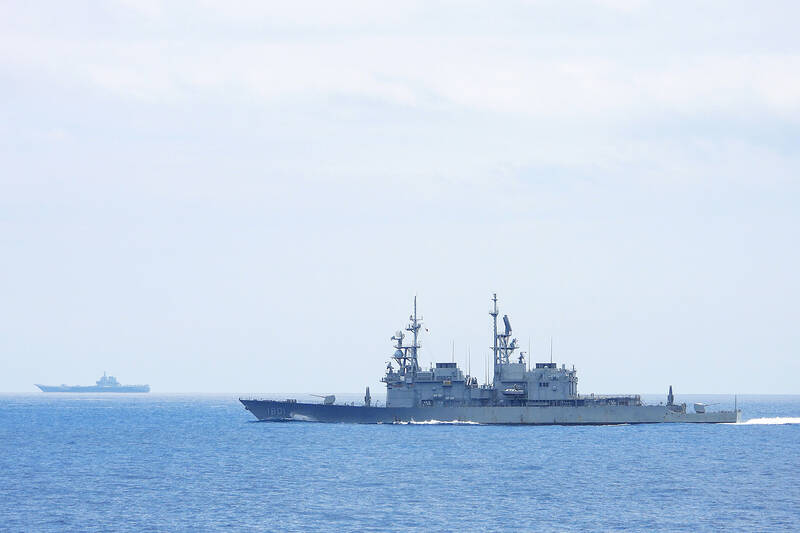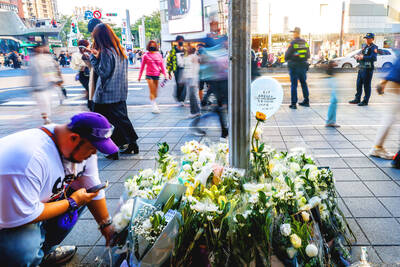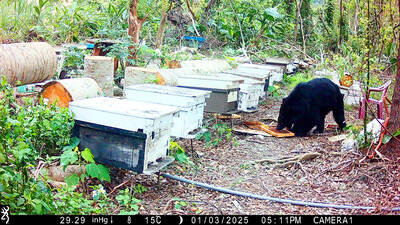The drills conducted by the Chinese aircraft carrier Shandong in the Western Pacific last week were more aimed at showcasing China’s military capabilities to the US rather than toward Taiwan, a Taiwanese defense expert said yesterday.
Lin Yin-yu (林穎佑), an assistant professor at Tamkang University’s Graduate Institute of International Affairs and Strategic Studies, said the drills which involved dozens of warplanes sought to test China’s anti-access and area denial capabilities should the US and its allies attempt to interfere in a cross-strait conflict.
Lin said that the latest Chinese drills coincided with a joint maritime exercise conducted by the US, South Korea and Canada that happened on the Yellow Sea on Thursday.

Photo: Taiwan Defense Ministry / AFP
The People’s Liberation Army (PLA) did not make more details of the Shandong drill public.
Taiwan’s Ministry of National Defense said that the Chinese-built aircraft carrier passed through the Bashi Channel at 60 nautical miles southeast of Oluanpi (鵝鑾鼻), and then headed east into the West Pacific for a long-range training session on Monday last week.
Meanwhile, Japan’s Minister of Defense said several rounds of drills involving warplanes and helicopters landing and taking off were held on the Shandong on Wednesday and Thursday last week, before the aircraft carrier concluded its drills on Thursday and Friday and headed to the South China Sea.
Lin said he does not believe that the two-day exercises in the West Pacific were cut short by the reported disappearance of Chinese Defense Minister Li Shangfu (李尚福).
Although Li is a general, he is not responsible for combat missions, as the position of defense minister mainly involves defense diplomacy, Lin said.
Li’s disappearance would not impact the PLA’s long-term combat preparedness or strategy, but it could mean the PLA is undergoing a high-level official reshuffle that could demoralize the Chinese military, Lin added.
Li, who was appointed defense minister in March, has been absent from public view for more than two weeks, fueling rumors about his fate after a series of unexplained personnel shakeups roiled the upper ranks of the Chinese Communist Party this summer.
US media reports have quoted unnamed government sources as saying Li is under investigation for corruption, and would likely be removed as general.
The Shandong is China’s second aircraft carrier, and the first to be entirely built by its domestic shipbuilding industry. It was commissioned into the PLA Navy on Dec. 17, 2019 in Sanya, Hainan Province.
The Liaoning, China’s first aircraft carrier, was launched in 2012. The vessel was a refurbished Soviet Kuznetsov-class cruiser carrier purchased in an incomplete state.
Meanwhile, China’s third and most advanced aircraft carrier, the Fujian, is expected to enter service after completing sea trials sometime next year.
Beijing launched the Fujian, on June 17, 2022. It is built to launch fighter jets with an electromagnetic catapult, a system on a par with the USS Gerald R. Ford, the US Navy’s most advanced carrier in service.
Taiwan’s defense experts have previously warned that the Shandong’s ability to conduct take-off and landing drills in the Pacific Ocean indicates it is a serious threat to eastern Taiwan.
The region, protected by the central mountain range on the west, has traditionally been used to preserve and maintain Taiwan’s combat readiness in the event of an invasion by the PLA.
It is essential for Taiwan to enhance its air defense capabilities and introduce additional runways in the eastern counties of Hualien and Taitung, given that the PLA is now capable of launching attacks from waters east of Taiwan, said retired Air Force Lieutenant General Chang Yen-ting (張延廷).

SHIPS, TRAINS AND AUTOMOBILES: The ministry has announced changes to varied transportation industries taking effect soon, with a number of effects for passengers Beginning next month, the post office is canceling signature upon delivery and written inquiry services for international registered small packets in accordance with the new policy of the Universal Postal Union, the Ministry of Transportation and Communications said yesterday. The new policy does not apply to packets that are to be delivered to China, the ministry said. Senders of international registered small packets would receive a NT$10 rebate on postage if the packets are sent from Jan. 1 to March 31, it added. The ministry said that three other policies are also scheduled to take effect next month. International cruise ship operators

HORROR STORIES: One victim recounted not realizing they had been stabbed and seeing people bleeding, while another recalled breaking down in tears after fleeing A man on Friday died after he tried to fight the knife-wielding suspect who went on a stabbing spree near two of Taipei’s busiest metro stations, Taipei Mayor Chiang Wan-an (蔣萬安) said. The 57-year-old man, identified by his family name, Yu (余), encountered the suspect at Exit M7 of Taipei Main Station and immediately tried to stop him, but was fatally wounded and later died, Chiang said, calling the incident “heartbreaking.” Yu’s family would receive at least NT$5 million (US$158,584) in compensation through the Taipei Rapid Transit Corp’s (TRTC) insurance coverage, he said after convening an emergency security response meeting yesterday morning. National

PLANNED: The suspect visited the crime scene before the killings, seeking information on how to access the roof, and had extensively researched a 2014 stabbing incident The suspect in a stabbing attack that killed three people and injured 11 in Taipei on Friday had planned the assault and set fires at other locations earlier in the day, law enforcement officials said yesterday. National Police Agency (NPA) Director-General Chang Jung-hsin (張榮興) said the suspect, a 27-year-old man named Chang Wen (張文), began the attacks at 3:40pm, first setting off smoke bombs on a road, damaging cars and motorbikes. Earlier, Chang Wen set fire to a rental room where he was staying on Gongyuan Road in Zhongzheng District (中正), Chang Jung-hsin said. The suspect later threw smoke grenades near two exits

The Forestry and Nature Conservation Agency yesterday launched a gift box to market honey “certified by a Formosan black bear” in appreciation of a beekeeper’s amicable interaction with a honey-thieving bear. Beekeeper Chih Ming-chen (池明鎮) in January inspected his bee farm in Hualien County’s Jhuosi Township (卓溪) and found that more than 20 beehives had been destroyed and many hives were eaten, with bear droppings and paw prints near the destroyed hives, the agency said. Chih returned to the farm to move the remaining beehives away that evening when he encountered a Formosan black bear only 20m away, the agency said. The bear